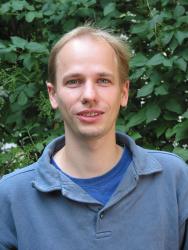 Dr. rer. nat., Dipl.-Biol.
Dr. rer. nat., Dipl.-Biol.Achim Schmalenberger
Research AssociateEcological Microbiology
At Department of Soil Ecology until 01/2004
e-Mail: Achim.Schmalenberger(at)man.ac.uk
University of Manchester, Biological Scienes
1.800 Stopford Building Oxford Road
M139 PT Manchester
Introduction:
Via acidic rain, sulfur components had been accumulated in forest soils of the Lehstenbach catchment in the Fichtelgebirge
Previous investigations revealed a potential reduction of sulfate in the upper 10 cm of an acidic fen (Schlöppnerbrunnen I) and the occurrence of sulfate reducing bacteria
Pure culture studies revealed the ability of some sulfate reducers I: to resist oxidative stress, II: to respire oxygen, III: to increase biomass
Since sphagnum moss may introduce oxygen into the upper layers of peat bog by photosynthesis, some of the sulfate reducers in the peat bog might be able to reduce sulfate under oxic conditions
Hypotheses:
The release of oxygen during the daytime by Sphagnum mosses affects the gradients of O2, H2S, pH, and SO4 in the upper 0-5 cm of the peat bog
Biogeochemical gradients in the upper zone affect the microbial community structures
Gene expression of the Dissimilatory bisulfite reductase (DSR) is influenced by diurnal changes and the vertical gradient of oxygen in peat bog
Some sulfate reducers synthesize mRNA from the dsr AB genes in the presence of oxygen to reduce sulfate
>> Personal homepage

